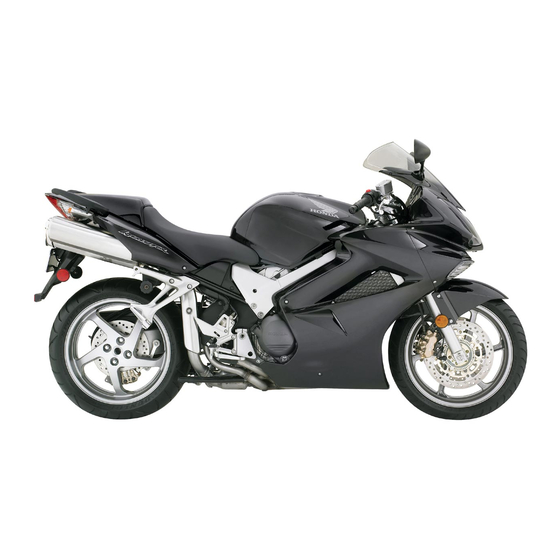
Table of Contents
Advertisement
This manual should be considered a permanent part of the motorcycle and should remain
with the motorcycle when it is resold.
This Owner's Manual covers the
INTERCEPTOR
and
INTERCEPTOR ABS
models. You
may find descriptions of equipment and features that are not on your particular model.
All illustrations are based on the
INTERCEPTOR ABS
model, unless noted otherwise.
This publication includes the latest production information available before printing. Honda
Motor Co., Ltd. reserves the right to make changes at any time without notice and without
incurring any obligation.
No part of this publication may be reproduced without written permission.
The vehicle pictured on the front cover may not match your vehicle.
2006 Honda Motor Co., Ltd.
Advertisement
Chapters
Table of Contents

Summarization of Contents
Motorcycle Safety
Important Safety Information
Provides essential recommendations for riding your motorcycle safely, including wearing protective gear.
Accessories & Modifications
Guidance on using genuine Honda accessories and the risks of modifications.
Safety Labels
Explains the purpose of safety labels and where to find replacements if they are damaged.
Instruments & Controls
Operation Component Locations
Illustrates the location of all gauges, indicators, and controls used while riding.
Gauges, Indicators & Displays
Details the functions of various gauges, indicators, and digital displays on the motorcycle.
Multi-function Display
Explains the functions of the left and right multi-function displays, including odometer and fuel gauge.
Before Riding
Are You Ready to Ride?
Covers rider preparation, including physical condition and protective apparel.
Is Your Motorcycle Ready to Ride?
Details the pre-ride inspection checklist for tires, brakes, lights, and other critical components.
Load Limits & Guidelines
Provides weight capacity and guidelines for safely loading passengers and cargo.
Basic Operation & Riding
Safe Riding Precautions
Offers fundamental safety advice for operating the motorcycle.
Starting & Stopping the Engine
Explains the proper procedures for starting and stopping the engine safely.
Braking
Details how to use the braking system effectively and safely for slowing and stopping.
Servicing Your Honda
The Importance of Maintenance
Highlights the essential role of regular maintenance for safety and performance.
Maintenance Schedule
Outlines the recommended service intervals for various motorcycle components.
Maintenance Component Locations
Illustrates the location of key components for servicing the motorcycle.
Tires
Air Pressure
Explains how to check and maintain correct tire air pressure for optimal performance.
Inspection
Guides on inspecting tires for wear, damage, and foreign objects.
Tire Repair
Provides recommendations on tire repair versus replacement and safety.
Taking Care of the Unexpected
General Guidelines
Provides basic principles for assessing and handling problems while riding.
If Your Engine Quits or Won’t Start
Troubleshooting steps for common starting and engine performance issues.
If You Have a Flat Tire
Guidance on dealing with flat tires, including temporary repairs and transport.
Technical Information
Vehicle Identification
Details where to find VIN and engine serial numbers for registration and parts.
Specifications
Provides key technical data including dimensions, capacities, and engine specs.
Emission Control Systems
Explains the systems designed to control vehicle emissions and compliance.
Consumer Information
Warranty Coverage
Outlines the types of warranties provided and responsibilities.
Contacting Honda
Information on how to contact Honda for questions or feedback.
Your Honda Dealer
Guidance on interacting with your local Honda dealer for services.
Quick Reference
How To Avoid Costly Repairs
Highlights common causes of expensive repairs and preventative maintenance.
















Need help?
Do you have a question about the VFR800A and is the answer not in the manual?
Questions and answers